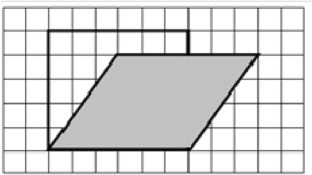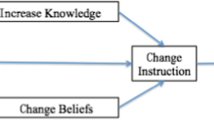Abstract
In this study we aimed to understand teaching mathematics through problem posing based on an analysis of 22 teaching cases. Teaching mathematics through problem posing starts with problem-posing tasks. This study provides not only specific examples of problem-posing tasks used in classrooms but also related task variables to consider when developing problem-posing tasks. This study also contributes to our understanding of how teachers can deal with student-posed problems in the classroom. In these 22 teaching cases, there was a typical pattern to how teachers dealt with the students’ posed problems in the classroom according to the instructional goals. For future research, we need to accumulate additional teaching cases and explore possible discourse patterns concerning how teachers handle students’ posed problems, as well as identify the most effective discourse patterns when teaching mathematics through problem posing.




Similar content being viewed by others
References
Australian Education Council. (1991). A national statement on mathematics for Australian schools: A jointproject of the States, Territories and the Commonwealth of Australia initiated by the Australian Education Council. . Curriculum Corporation.
Bryk, A. S., Gomez, L. M., Grunow, A., & LeMahieu, P. G. (2015). Learning to improve: How America’s schools can get better at getting better. . Harvard Education Press.
Cai, J. (2003). What research tells us about teaching mathematics through problem solving. In F. Lester (Ed.), Research and issues in teaching mathematics through problem solving. (pp. 241–254). National Council of Teachers of Mathematics.
Cai, J., Chen, T., Li, X., Xu, R., Zhang, S., Hu, Y., Zhang, L., & Song, N. (2020). Exploring the impact of a problem-posing workshop on elementary school mathematics teachers’ problem posing and lesson design. International Journal of Educational Research, 102, 101404.
Cai, J., & Hwang, S. (2002). Generalized and generative thinking in U.S. and Chinese students’ mathematical problem solving and problem posing. Journal of Mathematical Behavior, 21, 401–421.
Cai, J., & Hwang, S. (2020). Learning to teach mathematics through problem posing: Theoretical considerations, methodology, and directions for future research. International Journal of Educational Research. https://doi.org/10.1016/j.ijer.2019.01.001.
Cai, J., & Hwang, S. (2021). Teachers as re-designers of curriculum to teach mathematics through problem posing: Conceptualization and initial findings of a problem-posing project. ZDM-Mathematics Education.
Cai, J., Hwang, S., Jiang, C., & Silber, S. (2015). Problem posing research in mathematics: Some answered and unanswered questions. In F. M. Singer, N. Ellerton, & J. Cai (Eds.), Mathematical problem posing: From research to effective practice. Springer.
Cai, J., Hwang, S., Melville, M. & Robison, V. (in press). Theories for teaching and teaching for theories: Artifacts as tangible entities for storing and improving professional knowledge for teaching. In A. Praetorius & C. Y. Charalambous (Ed), Theorizing teaching. Springer.
Cai, J., & Jiang, C. (2017). An analysis of problem-posing tasks in Chinese and U.S. elementary mathematics textbooks. International Journal of Science and Mathematics Education, 15(8), 1521–1540.
Cai, J., Moyer, J. C., Wang, N., Hwang, S., Nie, B., & Garber, T. (2013). Mathematical problem posing as a measure of curricular effect on students’ learning. Educational Studies in Mathematics, 83, 57–69.
Cai, J., Wang, N., Moyer, J. C., Wang, C., & Nie, B. (2011). Longitudinal investigation of the curriculum effect: An analysis of student learning outcomes from the LieCal Project. International Journal of Educational Research, 50, 117–136.
Carpenter, T. P., Franke, M. L., Jacobs, V. R., Fennema, E., & Empson, S. B. (1998). A longitudinal study of invention and understanding in children’s multidigit addition and subtraction. Journal for Research in Mathematics Education, 29, 3–20.
Cazden, C. B. (1986). Classroom discourse: The language of teaching and learning. . Heinemann.
Chinese Ministry of Education. (2001a). Curriculum standards for school mathematics of nine-year compulsory education (Trial version). . Beijing Normal University Press.
Chinese Ministry of Education. (2001b). Guidelines for curriculum reform of elementary education (Trial version). . Beijing Normal University Press.
Chinese Ministry of Education. (2003). Curriculum standards of high school mathematics (Trial version). People’s Education Press.
Chinese Ministry of Education. (2011). Mathematics curriculum standard of compulsory education (2011 version). . Beijing Normal University Press.
Cobb, P., & Bauersfeld, H. (1995). The emergence of mathematical meaning: Interaction in classroom cultures. . Lawrence Erlbaum.
Cobb, P., Wood, T., Yackel, E., Nicholls, J., Wheatley, G., Trigatti, B., & Perlwitz, M. (1991). Assessment of a problem-centered second-grade mathematics project. Journal for Research in Mathematics Education, 22, 3–29.
Doyle, W. (1983). Academic work. Review of Educational Research, 53, 159–199.
Doyle, W. (1988). Work in mathematics classes: The context of students’ thinking during instruction. Educational Psychologist, 23, 167–180.
Ellerton, N. F. (2013). Engaging pre-service middle-school teacher-education students in mathematical problem posing: Development of an active learning framework. Educational Studies in Mathematics, 83(1), 87–101.
Forman, E., & Cazden, C. B. (1985). Exploring Vygotskian perspectives in education: The cognitive value of peer interaction. In J. V. Wertsch (Ed.), Culture, communication, and cognition: Vygotskian perspectives. (pp. 323–347). Cambridge University Press.
Fuson, K. C., Carroll, W. M., & Drueck, J. V. (2000). Achievement results for second and third graders using the standards-based curriculum everyday mathematics. Journal for Research in Mathematics Education, 31, 277–295.
Goldin, A. G., & Mcclintock, E. C. (1984). Task variables in mathematical problem solving. . Franklin Institute Press.
Hembree, R., & Marsh, H. (1993). Problem solving in early childhood: Building foundations. In R. J. Jenson (Ed.), Research ideas for the classroom: Early childhood mathematics. (pp. 151–170). National Council of Teachers of Mathematics.
Henningsen, M. A., & Stein, M. K. (1997). Mathematical tasks and students’ cognition: Classroom-based factors that support and inhibit high-level mathematical thinking and reasoning. Journal for Research in Mathematics Education, 28, 524–549.
Hiebert, J., Carpenter, T. P., Fennema, E., Fuson, K., Wearne, D., Murray, H., Olivier, A., & Human, P. (1997). Making sense: Teaching and learning mathematics with understanding. . Heinemann.
Hiebert, J., & Wearne, D. (1993). Instructional task, classroom discourse, and students’ learning in second grade. American Educational Research Journal, 30, 393–425.
Hillen, A. F., & Hughes, E. K. (2008). Developing teachers’ abilities to facilitate meaningful classroom discourse through cases: The case of accountable talk. In M. S. Smith & S. Friel (Eds.), Cases in mathematics teacher education: Tools for developing knowledge needed for teaching. AMTE Fourth monograph of the Association of Mathematics Teacher Educators.
Kilpatrick, J. (1987). Problem formulating: Where do good problems come from? In A. H. Schoenfeld (Ed.), Cognitive science and mathematics education. (pp. 123–147). Lawrence Erlbaum Associates.
Kontorovich, I., Koichu, B., Leikin, R., & Berman, A. (2012). An exploratory framework for handling the complexity of mathematical problem posing in small groups. The Journal of Mathematical Behavior, 31(1), 149–161.
Kroll, D. L., & Miller, T. (1993). Insights from research on mathematical problem solving in the middle grades. In D. T. Owens (Ed.), Research ideas for the classroom: Middle grades mathematics. (pp. 58–77). National Council of Teachers of Mathematics.
Lampert, M. (1990). When the problem is not the question and the solution is not the answer: Mathematical knowing and teaching. American Educational Research Journal, 27, 29–63.
Leinhardt, G. (1989). Math lessons: A contrast of novice and expert competence. Journal for Research in Mathematics Education, 20(1), 52–75.
Lloyd, G. M., Cai, J., & Tarr, J. E. (2017). Issues in curriculum studies: Evidence-based insights and future directions. In J. Cai (Ed.), Compendium for research in mathematics education. National Council of Teachers of Mathematics.
Lu, C., & Wang, B. (2006). Research on mathematics teaching through using mathematical situations and posing problems in high school and primary school [in Chinese]. . Guizhou People’s Publishing House.
Matsko, V. J., & Thomas, J. (2015). Beyond routine: Fostering creativity in mathematics classrooms. In F. M. Singer, N. F. Ellerton, & J. Cai (Eds.), Mathematical problem posing. (pp. 125–139). Springer.
Merseth, K. K. (2003). Windows on teaching math: Cases of middle and secondary classrooms. . Teachers College Press.
Merseth, K. K. (2016). The early history of case-based instruction: Insights for teacher education today. Journal of Teacher Education, 42(4), 243–249.
Ministry of Education (Singapore). (2012). Primary mathematics teaching and learning Syllabus. . Author.
National Council of Teachers of Mathematics. (1989). Curriculum and evaluation standards for school mathematics. . Author.
National Council of Teachers of Mathematics. (1991). Professional standards for teaching mathematics. . Author.
National Council of Teachers of Mathematics. (2000). Principles and standards for school mathematics. . Author.
Perry, M., VanderStoep, S. W., & Yu, S. L. (1993). Asking questions in first-grade mathematics classes: Potential influences on mathematical thought. Journal of Educational Psychology, 85, 31–40.
Resnick, L. B. (1989). Developing mathematical knowledge. American Psychologist, 44, 162–169.
Ridgeway, J., Zawojewski, J. S., Hoover, M. N., & Lambdin, D. (2002). Student attainment in the connected mathematics curriculum. In S. Senk & D. Thompson (Eds.), Standards-oriented school mathematics curricula: What are they? What do students learn? Lawrence Erlbaum Associates.
Romberg, T. A., & Shafer, M. (2002). Mathematics in Context (MiC): Preliminary evidence about student outcomes. In S. Senk & D. Thompson (Eds.), Standards-oriented school mathematics curricula: What are they? What do students learn? Lawrence Erlbaum Associates.
Schroeder, T. L., & Lester, F. K., Jr. (1989). Developing understanding in mathematics via problem solving. In P. R. Trafton (Ed.), New directions for elementary school mathematics. (pp. 31–42). National Council of Teachers of Mathematics.
Silber, S., & Cai, J. (2017). Pre-service teachers’ free and structured mathematical problem posing. International Journal of Mathematical Education in Science and Technology, 48(2), 163–184.
Silver, E. A., & Cai, J. (1996). An analysis of arithmetic problem posing by middle school students. Journal for Research in Mathematics Education, 27(5), 521–539.
Singer, F. M., Ellerton, N., & Cai, J. (Eds.). (2015). Mathematical problem posing: From research to effective practice. . Springer.
Singer, F. M., & Moscovici, H. (2008). Teaching and learning cycles in a constructivist approach to instruction. Teaching and Teacher Education, 24(6), 1613–1634.
Smith, M. S., Boyle, J., Arbaugh, F., Steele, M. D., & Stylianides, G. (2014). Cases as a vehicle for developing knowledge needed for teaching. In Y. Li, E. A. Silver, & S. Li (Eds.), Transforming mathematics instruction: Multiple approaches and practices. Cham: Springer.
Stein, M. K., Grover, B. W., & Henningsen, M. A. (1996). Building student capacity for mathematical thinking and reasoning: An analysis of mathematical tasks used in reform classrooms. American Educational Research Journal, 33, 455–488.
Stein, M. K., Henningsen, M. A., Smith, M. S., & Silver, E. A. (2009). Implementing standards-based mathematics instruction: A casebook for professional development. (2nd ed.). Teachers College Press.
Stein, M. K., Smith, M. S., & Silver, E. A. (1999). The development of professional developers. Harvard Educational Review, 69, 237–269.
Tarr, J. E., Reys, R. E., Reys, B. J., Chavez, O., Shih, J., & Osterlind, S. J. (2008). The impact of middle-grades mathematics curricula and the classroom learning environment on student achievement. Journal for Research in Mathematics Education, 39(3), 247–280.
Thompson, A. G. (1992). Teachers’ beliefs and conceptions: A synthesis of the research. In D. A. Grouws (Ed.), Handbook of research on mathematics teaching and learning. (pp. 127–146). Macmillan.
Williams, S. M. (1992). Putting case-based instruction into context: Examples from legal and medical education. The Journal of the Learning Sciences, 2(4), 367–427.
Yoon, K. S., Duncan T., Lee, S. W., Scarloss, B., & Shapley, K. L. (2007). Reviewing the evidence on how teacher professional development affects student achievement (Issues and Answers Report REL 2007, No. 033). U.S. Department of Education, Institute of Education Sciences, National Center for Education Evaluation and Regional Assistance, Regional Educational Laboratory Southwest.
Author information
Authors and Affiliations
Corresponding author
Additional information
Publisher's Note
Springer Nature remains neutral with regard to jurisdictional claims in published maps and institutional affiliations.
Rights and permissions
About this article
Cite this article
Zhang, H., Cai, J. Teaching mathematics through problem posing: insights from an analysis of teaching cases. ZDM Mathematics Education 53, 961–973 (2021). https://doi.org/10.1007/s11858-021-01260-3
Accepted:
Published:
Issue Date:
DOI: https://doi.org/10.1007/s11858-021-01260-3




